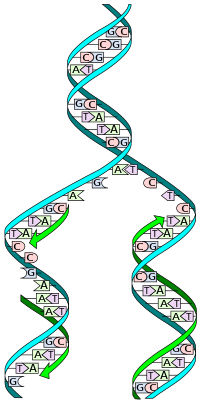
The N-terminal domain of the A12.2 subunit stimulates RNA polymerase I transcription elongation.
Sign Up to like & getrecommendations! Published in 2021 at "Biophysical journal"
DOI: 10.1016/j.bpj.2021.03.007
Abstract: Eukaryotes express three DNA-dependent RNA polymerases (Pols) which are responsible for the entirety of cellular genomic expression. The three Pols have evolved to express specific cohorts of RNAs, and thus have diverged both structurally and… read more here.
Keywords: terminal domain; pol; a12 subunit; subunit ... See more keywords

Kmt5a Controls Hepatic Metabolic Pathways by Facilitating RNA Pol II Release from Promoter-Proximal Regions
Sign Up to like & getrecommendations! Published in 2017 at "Cell Reports"
DOI: 10.1016/j.celrep.2017.07.003
Abstract: Summary H4K20 monomethylation maintains genome integrity by regulating proper mitotic condensation, DNA damage response, and replication licensing. Here, we show that, in non-dividing hepatic cells, H4K20Me1 is specifically enriched in active gene bodies and dynamically… read more here.
Keywords: pol release; pol; release promoter; rna pol ... See more keywords

Pol V-Mediated Translesion Synthesis Elicits Localized Untargeted Mutagenesis during Post-replicative Gap Repair.
Sign Up to like & getrecommendations! Published in 2018 at "Cell reports"
DOI: 10.1016/j.celrep.2018.06.120
Abstract: In vivo, replication forks proceed beyond replication-blocking lesions by way of downstream repriming, generating daughter strand gaps that are subsequently processed by post-replicative repair pathways such as homologous recombination and translesion synthesis (TLS). The way these… read more here.
Keywords: gap; post replicative; gap repair; pol ... See more keywords

Alternative splicing at exon 2 results in the loss of the catalytic activity of mouse DNA polymerase iota in vitro.
Sign Up to like & getrecommendations! Published in 2017 at "DNA repair"
DOI: 10.1016/j.dnarep.2017.01.001
Abstract: Y-family DNA polymerase iota (Pol ι) possesses both DNA polymerase and dRP lyase activities and was suggested to be involved in DNA translesion synthesis and base excision repair in mammals. The 129 strain of mice… read more here.
Keywords: dna; dna polymerase; polymerase iota; pol ... See more keywords

Deployment of DNA polymerases beta and lambda in single-nucleotide and multinucleotide pathways of mammalian base excision DNA repair.
Sign Up to like & getrecommendations! Published in 2019 at "DNA repair"
DOI: 10.1016/j.dnarep.2019.02.001
Abstract: There exist two major base excision DNA repair (BER) pathways, namely single-nucleotide or "short-patch" (SP-BER), and "long-patch" BER (LP-BER). Both pathways appear to be involved in the repair of small base lesions such as uracil,… read more here.
Keywords: dna repair; dna; base; pol ... See more keywords

Two forms of human DNA polymerase δ: Who does what and why?
Sign Up to like & getrecommendations! Published in 2019 at "DNA repair"
DOI: 10.1016/j.dnarep.2019.102656
Abstract: DNA polymerase δ (Pol δ) plays a central role in lagging strand DNA synthesis in eukaryotic cells, as well as an important role in DNA repair processes. Human Pol δ4 is a heterotetramer of four… read more here.
Keywords: dna; dna polymerase; pol; role ... See more keywords

History of DNA polymerase β X-ray crystallography.
Sign Up to like & getrecommendations! Published in 2020 at "DNA repair"
DOI: 10.1016/j.dnarep.2020.102928
Abstract: DNA polymerase β (Pol β) is an essential mammalian enzyme involved in the repair of DNA damage during the base excision repair (BER) pathway. In hopes of faithfully restoring the coding potential to damaged DNA… read more here.
Keywords: ray crystallography; pol; dna polymerase; dna ... See more keywords

Korean Red Ginseng increases defective pol gene in peripheral blood mononuclear cells of HIV-1–infected patients; inhibition of its detection during ginseng-based combination therapy
Sign Up to like & getrecommendations! Published in 2019 at "Journal of Ginseng Research"
DOI: 10.1016/j.jgr.2019.05.011
Abstract: Background We have reported that defective nef and gag genes are induced in HIV-1–infected patients treated with Korean Red Ginseng (KRG). Methods To investigate whether KRG treatment and highly active antiretroviral therapy (HAART) affect genetic… read more here.
Keywords: detection; ginseng; haart; pol ... See more keywords

Polε Instability Drives Replication Stress, Abnormal Development, and Tumorigenesis
Sign Up to like & getrecommendations! Published in 2018 at "Molecular Cell"
DOI: 10.1016/j.molcel.2018.04.008
Abstract: Summary DNA polymerase ε (POLE) is a four-subunit complex and the major leading strand polymerase in eukaryotes. Budding yeast orthologs of POLE3 and POLE4 promote Polε processivity in vitro but are dispensable for viability in… read more here.
Keywords: tumorigenesis; replication stress; pol; replication ... See more keywords

The Mcm2-Ctf4-Polα Axis Facilitates Parental Histone H3-H4 Transfer to Lagging Strands.
Sign Up to like & getrecommendations! Published in 2018 at "Molecular cell"
DOI: 10.1016/j.molcel.2018.09.001
Abstract: Although essential for epigenetic inheritance, the transfer of parental histone (H3-H4)2 tetramers that contain epigenetic modifications to replicating DNA strands is poorly understood. Here, we show that the Mcm2-Ctf4-Polα axis facilitates the transfer of parental… read more here.
Keywords: strand; pol; parental histone; transfer ... See more keywords

Protective effects of quercetin, polydatin, and folic acid and their mixtures in a zebrafish (Danio rerio) fetal alcohol spectrum disorder model.
Sign Up to like & getrecommendations! Published in 2020 at "Neurotoxicology and teratology"
DOI: 10.1016/j.ntt.2020.106928
Abstract: Protective effects of quercetin (QUE), polydatin (POL), and folic acid (FA) and their mixtures were tested using zebrafish to model fetal alcohol spectrum disorder in this study. Zebrafish embryos were exposed to 150 mM ethanol for… read more here.
Keywords: folic acid; que pol; effects quercetin; pol ... See more keywords